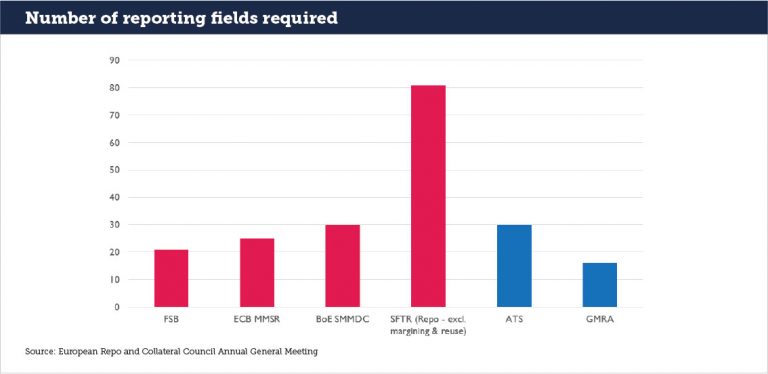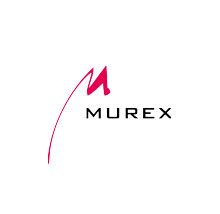The evolution of capital markets, including complex regulations such as the Securities Financing Transactions Regulation (SFTR), has resulted in a need to manage and understand data as a core function, if not the core function, of a financial markets institution. In this machine age, financial institutions must take a new focus on data management to be most effective. It’s really about data. A guest post from Murex.
The typical focus of a trader is volumes and revenues; this has not changed since trading began. And yet, the responsibilities of the broader financial services organization make the trader’s life complicated. There are realms of oversight, characterized by frequent regulatory and capital reporting, that can distract traders from executing on their basic business function.
Concurrently, cost reductions are creating strains at business organizations that used to rely on human resources to execute business activities. At some firms, there appears to be a question of which comes first: technology investment or cost management? When there is strong technology investment, fewer people can manage a broader array of tasks. But equally, firms at times seem keen to reduce staff but have not yet made the investment in technology that enables meeting business continuity objectives. This leads to a scramble to acquire technology to support critical needs like maximum automation (low-touch) and reporting to clients and regulators.
In the old model, technology vendors’ solutions worked a lot like a spreadsheet: requirements were met on a two-dimensional basis with rows and columns. On the first row was the trading technology, serving the front office. On the second row was operations technology, serving the middle office. On the third row was the settlement technology, serving the back office. Each column represented a particular trading activity: institutional equities, fixed income, cash and credit, securities finance and derivatives. In addition to this segregation of duties between front office and operations, there was a segregation even between different trading desks. Each was looking for coverage, financing or collateral from external sources as they moved from the micro or business unit to the broader macro bank view.
Under the previous model, each cell of the technology spreadsheet had its own distinct solution. For vendors, the main goal was to be best in class in the one or two niches they occupied within the larger ecosystem. For clients, the technical challenge was to connect the various systems together so that the math worked – everything added up across and everything tallied properly down. The result was a complex topology of different systems that would struggle to work together, using different technologies, each supported by its own team. The questions often asked by the business were generally only evoked as part of post-event analysis and ranged from: “What happened?” to, “Why did that happen?” in the best-case scenario.
The new model has removed the distinctions between both business units and functional roles in the service of data integration. Functionally, many technology platforms do much the same thing as always, but there should be no surprise that technology vendors have converged from their starting points (derivatives, financing, collateral) towards a central offering across divisions. In this regard, technology vendors are merely following the needs of their clients to support an integrated data view of the firm’s activity across business units.
Due to the rise in the frequency and cost of internal position transfer, traditional silo business units are increasingly converging. In the case of securities finance desks specifically, they are often merging with risk, collateral, fixed income or equity desks.
Murex has built a fit-for-purpose solution for this new way of working. A smart position and cost transfer tool enables traders to easily move a position and its cost to the appropriate desk and finance the lending desk internally. The unified inventory metrics monitor profitability, exposure and Basel III limits, optimize financing and deliver seamless integration of instruments along the full value chain. This is fundamental to overcoming new challenges and increasing competitiveness.
The front-middle-back office integration
While the horizontal breakdown in business separation has been well charted, a newer phenomenon is the breakdown in division between the front, middle and back office. Front office used to be for trading, middle office for allocations and back office for clearing and settlement. Now, many clearing and settlement decisions start in the front office, for example the calculation of margin for OTC derivatives or centrally cleared transactions. If decision making were left until after a trade was completed, this could result in added expense and even a loss of profitability in the trade. The back office role has moved up to front office, otherwise not much else makes sense.
A greater degree of automation has also supported the breakdown in roles. In a pre-machine age environment, middle and back office staff were required to deliver on front office revenue generation. The more that transactions processing has become automated, the fewer middle and back office staff are needed to get the job done; in some cases, the front office trader is expected to manage the process. While a functional middle and back office still exists, what used to be called the front office can be where trading, allocations, clearing and settlement happen. The people who work there manage those activities, including traders, product managers, technology and operations teams.
Blurred lines between the front, middle and back office have condensed major layers of data as well. The systems that once tallied balance sheet or compliance positions and inventory, which used to work on a spreadsheet matrix, are now able to reference profitability, counterparty risk exposure and settlement exposure, as well as other cross-functional metrics, all at the same time.
In MX.3, we built an exposure management time ladder and settlement aware exposure into our portfolio management dashboard for securities finance, as these now play a major role in trading decisions. Moreover, MX.3 metrics monitor price correlation and FX impact between the collateral and loan legs, which are now crucial requirements to reduce settlement costs.
MX.3 for Securities Finance facilitates regulatory compliance and allows users to vary distribution channels and leverage fast and accurate analytics to make better informed decisions, while managing high-volume Straight-through Processing. Traderscan now have access to a system that predicts what might happen next and proposes what should be done as opposed to the old post trading analysis that many firms still rely on today.
Collateral optimization is a good example of how the front, middle and back office separation has lost relevance. Where once there was a linear hierarchy of inventory management, now there is an on-going calculation to determine the best and most profitable utilization. This requires that former back office and middle office systems be engaged in front office decisions, feeding information up the columns of the spreadsheet; and that trading systems feed data across the row in both directions.
At the same time, across the middle of the stack, balance sheet and credit allocation has become equally dynamic, and these systems have needed to adapt to determine in real time the most profitable use of these precious commodities. In the settlements realm, systems now need to understand netting requirements on deliverable collateral; and to aggregate multiple instructions to avoid over and under delivery across bilateral and centralized clearing mechanisms. Back office systems also need to understand internal transfer of inventory across multiple lines of business as a preferred alternative to external inventory financing.
The era of the specialist, niche application that fits neatly into one or two rows or columns in the stack is over. Instead, capital markets firms are looking for systems that encompass all the complexity and are able to understand and adapt to the reality of today’s business process. These systems need to understand physical financing, closed and open-ended trades, collateral utilization, collateral allocations, inventories and settlements, derivatives and synthetics – and to bring all these considerations together into a front-to-back view of the business.
A data-driven business ecosystem
The need to move data quickly and effectively is the hallmark of today’s financial services institutions. From an architecture perspective, this looks more like a web of interconnected systems and modules – with no fixed starting or ending point – than the historical spreadsheet or set of building blocks.
The business process is now a continuum in which trading, middle and back office systems interact on a dynamic basis. Though many firms have emerged from the long period of stagnation into a new era of higher volumes and increased profitability, that profitability is still driven mainly by cost efficiencies. Margins remain tight, and fees continue to be driven downward both by competition and the demand for regulatory transparency.
Murex’s solution offers a wide palette of financing tools from synthetics to physical equities and physical fixed income including packaged tri-party interfaces to BNY Mellon, Clearstream and Euroclear. The platform is open and flexible integrating with other systems in the institutions ecosystem.
The market needs a system that handles all those financing tools in a holistic approach, where trade booking proposes fees or interest that matches source cost, is dependent on the price correlation between collateral and loan, then transfer the cost back to the requesting business unit. Moreover, the system should propagate lending fee costs to other derivatives units that profit from this asset.
In the same way, the demand on the part of regulators for more data through initiatives like the Securities Financing Trade Repository (SFTR) and MiFID II in Europe is unlikely to decrease. As has been shown through the difficulties of implementing SFTR, the rationalization and reconciliation of data across industry participants continues to be difficult to map out. ISLA and ERCC have recently joined forces as they realized the importance for firms to think across fixed income and equity markets to ensure a consistent approach around key issues including data and technology. The issue is the cost and complexity of data management; firms that have mastered the challenge of data management are now prepared for a wide variety of transparency obligations, not to mention easing their internal management burdens. These firms are in the minority however, and most still need to invest in these areas.

Firms using a single enterprise platform, such as Murex, will already have all the data necessary for SFTR reporting. Murex is actively working on assuring that the evolution of this data through the trade lifecycle is compliant with ESMA technical standards. Clients and vendors need to join forces to standardize the market practice on repo and stock loan business in order to minimize the breaks. As a vendor, we know that each client today has its own way to manage the trade lifecycle and reporting and this will be a major challenge for the reconciliation of pre- and post-trade repository posting.
The new ecosystem has another unique feature: the breakdown between cash and derivatives. These were once two fully separate business functions, but in today’s market they have become closely intertwined and require the same technology to manage the range of transactions. Systems that can look at these questions holistically and comparatively against physical financing are becoming a necessity.
As firms look to build going forward, data management will remain critical to managing through regulatory and business model complexity. Whether called transparency, digital transformation or something else, data management is the central challenge of the modern financial institution. Some would also call it the defining characteristic of success as well.
 Sabine Farhat-Dupla is Head of Securities Finance Product Management at Murex. She leads the MX.3 product evolution for Repo, Stock Loan, Buy/Sell Backs, and the full synthetics offering. Her recent work has focused on preparing the securities finance solution for physical and synthetics to the new market demands by enhancing the whole value chain front to back to risk for high-volume Straight-through Processing offering and continuously focusing on SFTR regulation. Sabine holds a master’s degree in management of Financial Institutions from Université Paris Dauphine.
Sabine Farhat-Dupla is Head of Securities Finance Product Management at Murex. She leads the MX.3 product evolution for Repo, Stock Loan, Buy/Sell Backs, and the full synthetics offering. Her recent work has focused on preparing the securities finance solution for physical and synthetics to the new market demands by enhancing the whole value chain front to back to risk for high-volume Straight-through Processing offering and continuously focusing on SFTR regulation. Sabine holds a master’s degree in management of Financial Institutions from Université Paris Dauphine.



